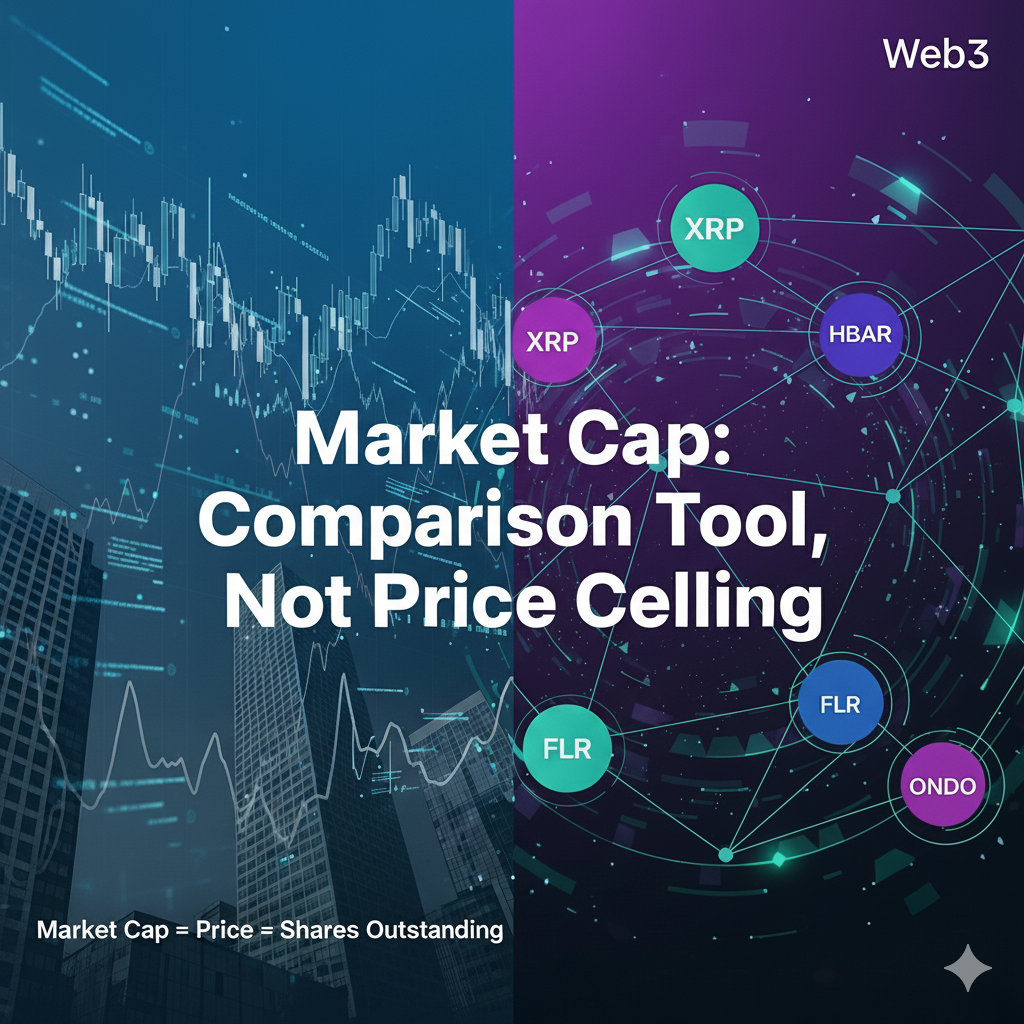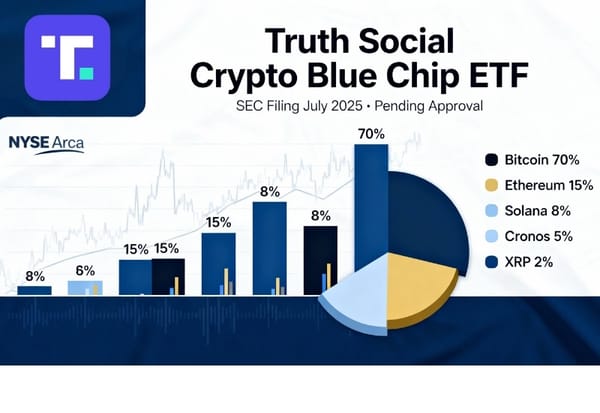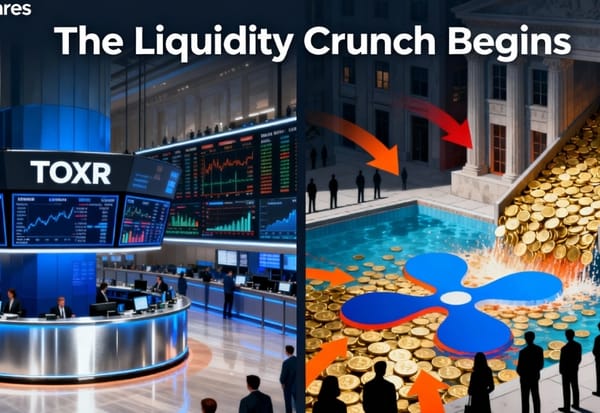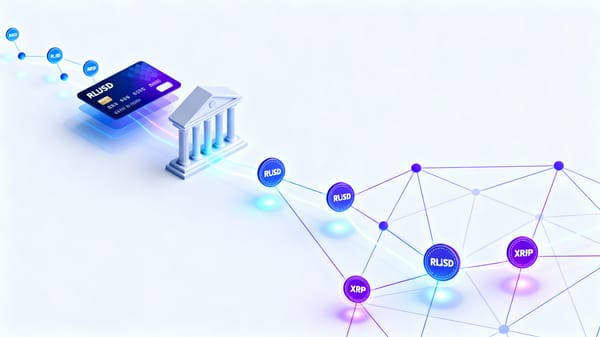Market Cap Misunderstanding: TradFi to Crypto - Why It's a Survey, Not a Boundary
The crypto market cap debate is heating up. NVIDIA grew 736,585% from IPO to $4.15T, proving market cap isn't a price ceiling. Web3 assets like XRP need new valuation models—they're network utility tools, not traditional stocks. Why the old TradFi rules don't apply to blockchain protocols.

The crypto space is buzzing with heated debates over market capitalization, and nowhere is this more evident than in the recent clash between Ripple CTO David Schwartz and Litecoin advocates. The conflict highlights a fundamental misunderstanding plaguing cryptocurrency discussions: the belief that market cap somehow dictates price ceilings.
This misconception has reached fever pitch as influencers and analysts routinely dismiss ambitious price predictions with phrases like "that's impossible because the market cap would be bigger than Bitcoin" or "XRP can't reach $100 because it would exceed Apple's valuation." These arguments reveal a deep misunderstanding of what market capitalization actually represents and how it functions in both traditional finance and the emerging Web3 ecosystem.
The Origin Story of Market Capitalization
Market capitalization wasn't designed as a crystal ball for predicting maximum asset values—it was created as a comparative tool. Born from traditional finance's need to standardize comparisons between companies with vastly different stock prices, market cap serves one primary purpose: helping investors compare relative company sizes on an apples-to-apples basis.
The concept emerged in the early 20th century as stock markets matured and investors needed better ways to evaluate companies. When investors wanted to compare a company trading at $10 per share with another at $200 per share, they needed a way to see which was actually "bigger." Market cap solved this by multiplying share price by total outstanding shares, creating a standardized metric for comparison.
But here's the crucial point that many crypto critics miss: market cap is a purely speculative measure that reflects current sentiment, not fundamental limits. It represents what the market collectively believes a company or asset is worth at a specific moment in time—nothing more, nothing less.
Market cap serves as a snapshot of investor sentiment and provides a useful comparison tool, but it was never intended to function as a ceiling or constraint on future growth. The formula is elegantly simple: Market Cap = Price × Circulating Supply. However, the implications drawn from this calculation have become dangerously oversimplified in crypto discourse.
Why TradFi Companies Shattered the "Market Cap Ceiling" Myth
If market cap truly imposed price limits, companies like NVIDIA and Tesla would still be stuck at their IPO valuations. Let's examine the evidence that completely demolishes the market cap ceiling argument:
NVIDIA's Explosive Growth:
- IPO Market Cap (January 1999): $560 million
- Current Market Cap (September 2025): $4.15 trillion
- Growth: 736,585% increase over 26 years
- Compound Annual Growth Rate: 39.7%
When NVIDIA went public in 1999, few could have imagined that this graphics card company would eventually become the world's most valuable corporation.
The company's journey from a $560 million market cap to over $4 trillion represents one of the most dramatic value creation stories in financial history.
NVIDIA's growth wasn't gradual—it came in waves as the company found new applications for its technology. First came gaming, then cryptocurrency mining, and finally artificial intelligence. Each wave brought exponential growth that would have been "impossible" according to traditional market cap thinking.
Tesla's Revolutionary Rise:
- IPO Market Cap (June 2010): $1.7 billion
- Current Market Cap (September 2025): $1.07 trillion
- Growth: 47,441% increase over 15 years
- Compound Annual Growth Rate: 50.1%
Tesla's story is equally compelling. When the company went public in 2010, it was widely dismissed as a niche electric vehicle startup with limited prospects. Traditional automakers and analysts argued that Tesla's market cap was already "too high" at its IPO valuation. Yet the company grew from $1.7 billion to over $1 trillion in market cap—a increase that defied every traditional valuation model.
Both examples share common characteristics: they started as innovative companies in emerging sectors, faced skepticism about their valuations, and ultimately grew far beyond what traditional metrics suggested was possible. Most importantly, their growth came not from speculation alone, but from expanding utility, adoption, and strategic importance in the global economy.
The Pattern: Utility Drives Valuation
These examples demolish the argument that assets cannot grow beyond certain market cap thresholds. Both companies started with "reasonable" valuations but grew exponentially as their utility, adoption, and strategic importance increased. The market repeatedly "repriced" these assets upward as their fundamental value propositions became clearer and more valuable.
This pattern suggests that for truly innovative assets—whether traditional stocks or crypto tokens—market cap serves as a trailing indicator of value recognition, not a leading constraint on growth potential.
The Litecoin vs. XRP Controversy: A Case Study in Misunderstanding
The recent Twitter feud between Litecoin supporters and the XRP community perfectly illustrates this misconception in action. According to multiple reports, Litecoin's official account posted that it had "roasted" other crypto projects with lighthearted reactions, "but when it criticized XRP, it received legal threats and nonstop angry replies" along with "horrible takes on market cap."
The controversy erupted when Litecoin influencer @jonnylitecoin questioned XRP's value, stating "I have never once seen a XRP transaction done in the real world" and concluding that "XRP is a psychological operation meant to distract you". He followed up by arguing that Litecoin's value comes from its proof-ofwork mining process, which requires real energy and resources, while XRP was created "for free" and "out of thin air."
Ripple CTO David Schwartz fired back with a pointed response about energy efficiency, asking: "Two products are equivalent except that one takes much more energy to make than the other. Which one do you think is the most likely to grow in popularity over time?"
The exchange highlighted a fundamental divide in crypto thinking. Litecoin advocates applied traditional "proof of work = value" logic, while Ripple supporters emphasized utility and efficiency. But beneath the surface, the real issue was competing interpretations of what drives asset valuation in the digital age.
The underlying tension reveals a deeper issue: many crypto participants still apply outdated TradFi valuation models to Web3 assets. This misapplication creates artificial constraints that don't reflect the fundamental differences between traditional companies and blockchain protocols.
Why Web3 Demands Different Valuation Models
Traditional market cap calculations become even more problematic when applied to Web3 ecosystems. The crypto space operates under fundamentally different principles that make traditional valuation methods inadequate:
1. Functional Utility vs. Equity Stakes
Unlike traditional stocks representing ownership stakes in companies, many crypto tokens represent entirely different value propositions:
- Network utility and access rights - Tokens that provide access to specific blockchain services or functionalities
- Governance participation - Voting rights in decentralized autonomous organizations (DAOs)
- Protocol fee mechanisms - Revenue sharing from network transaction fees
- Liquidity provisioning tools - Assets used to facilitate trading and settlement
- Staking rewards - Returns generated from network validation participation
These utility functions create value in ways that traditional market cap calculations simply cannot capture. A token's value may derive from its ability to reduce transaction costs, enable new financial products, or provide access to previously impossible services.
2. Artificial Scarcity Distortions
The crypto market is rife with artificial scarcity mechanisms that skew traditional market cap calculations:
- Locked tokens - Large portions of supply held in smart contracts or by foundations
- Vesting schedules - Gradual release of tokens over time
- Burn mechanisms - Systematic destruction of tokens to reduce supply
- Staking requirements - Tokens locked for network validation
These mechanisms create misleading market cap calculations that don't reflect actual circulating liquidity or adoption metrics. The "fully diluted" market cap may suggest astronomical valuations while the actual liquid market remains relatively small.
3. Network Effects and Liquidity Requirements
As business leader Jake Claver explains, XRP "operates as a high-volume liquidity and settlement network designed to handle trillions in daily transactions" and therefore "valuing XRP using the traditional market cap system does not make sense".
Claver, who transitioned from traditional finance to become founder of Digital Ascension Group, brings a unique perspective having worked in both TradFi and DeFi environments. His analysis emphasizes that XRP's role in the financial system resembles "a global highway rather than a single product-producing company."
Crypto analyst Versan Aljarrah echoes this sentiment, arguing that the growing tokenization market "requires a high value bridge asset to function" and that "demand can't be met with a low $XRP price".
Aljarrah, CEO of Black Swan Capitalist, has extensively analyzed the relationship between asset prices and network functionality. His research suggests that certain blockchain protocols require higher token prices to fulfill their intended economic functions effectively.
The Liquidity Problem: Why Higher Prices Enable Greater Utility
This brings us to a critical concept that traditional market cap critics miss: for certain Web3 assets, higher prices directly enable greater functionality. This represents a fundamental departure from traditional assets where price primarily reflects investor sentiment rather than operational capability.
Consider XRP's intended use case for institutional cross-border payments:
- Moving $1 million at $1 per XRP requires 1 million tokens
- Moving $1 million at $10 per XRP requires 100,000 tokens
- Moving $1 million at $100 per XRP requires only 10,000 tokens
- Moving $1 million at $1,000 per XRP requires only 1,000 tokens
As Aljarrah notes, "If you were to answer the question about how XRP starts getting to these high valuations —like $100, $1,000, or even $100,000—it has to actually support the global financial ecosystem."
The math becomes compelling when considering the scale of global financial flows. The Bank for International Settlements estimates that daily foreign exchange trading exceeds $7.5 trillion. For a bridge asset to facilitate even a fraction of this volume efficiently, it needs substantial per-unit value to minimize the number of tokens required for large transactions.
This creates what economists call a "network effect"—as more institutions adopt the network, demand for the native token increases, driving up price and making the network more efficient for large-scale operations. Higher prices actually improve the system's functionality rather than creating unsustainable valuations.
Beyond Bitcoin: Why Newer Crypto Assets Play by Different Rules
While Bitcoin primarily functions as digital gold—a store of value and hedge against inflation—newer Web3 assets like XRP, Flare (FLR), Ondo (ONDO), and Hedera (HBAR) serve fundamentally different purposes in the digital economy:
XRP: The Global Settlement Layer
- Primary Function: Cross-border liquidity and settlement
- Utility Driver: Transaction volume and institutional adoption
- Value Source: Network efficiency and regulatory clarity
XRP was designed specifically for institutional use cases, with features like fast settlement times (3-5 seconds) and low transaction costs ($0.0002 per transaction). Its value proposition strengthens as more financial institutions adopt it for cross-border payments.
Flare (FLR): Blockchain Interoperability
- Primary Function: Connecting different blockchain networks
- Utility Driver: Cross-chain transaction volume
- Value Source: Bridge functionality between isolated networks
Flare enables smart contracts on networks that don't natively support them, creating value through interoperability. As the multi-chain ecosystem grows, demand for bridging solutions increases.
Ondo (ONDO): Institutional Tokenization
- Primary Function: Institutional-grade tokenized securities
- Utility Driver: Traditional asset tokenization demand
- Value Source: Compliance and regulatory frameworks
Ondo focuses on bringing traditional financial assets onto blockchain infrastructure with proper regulatory compliance, targeting institutional investors seeking blockchain exposure.
Hedera (HBAR): Enterprise Blockchain
- Primary Function: Enterprise-focused distributed ledger
- Utility Driver: Corporate adoption and use cases
- Value Source: Enterprise-grade performance and governance
Hedera positions itself as an enterprise-ready blockchain with predictable fees and high throughput, targeting business applications that require stability and performance.
These assets derive value from network utility and adoption rather than scarcity alone, making traditional market cap comparisons increasingly irrelevant. Each serves specific use cases in the broader Web3 ecosystem, and their valuations should reflect their success in capturing and facilitating economic activity within their respective niches.
The Expert Consensus: Market Cap as a Tool, Not a Rule
Leading voices in both traditional finance and crypto agree that market cap limitations are largely psychological constraints rather than economic realities.
Jake Claver's Traditional Finance Perspective
Jake Claver, who transitioned from traditional finance to digital assets as founder of Digital Ascension Group, emphasizes that "financial world once believed trillion-dollar valuations were impossible" yet "companies like Apple, Microsoft, and Saudi Aramco have shattered those expectations."
Claver's background in traditional M&A and wealth management provides valuable perspective on how institutional investors evaluate emerging asset classes. His analysis suggests that crypto assets should be evaluated based on their ability to capture and facilitate economic activity rather than arbitrary market cap comparisons.
In his analysis of XRP specifically, Claver argues that traditional valuation models fail because they don't account for the token's role as infrastructure rather than investment. "XRP's value proposition lies in its ability to efficiently move large sums of money, making it an essential tool for banks and financial institutions," he explains.
Versan Aljarrah's Web3 Analysis
Meanwhile, Versan Aljarrah argues that XRP's current price "doesn't reflect its utility, adoption, or strategic position" due to "layered, coordinated suppression mechanisms" rather than fundamental market cap constraints.
Aljarrah's research focuses on the disconnect between crypto assets' real-world utility and their market valuations. He argues that regulatory uncertainty, exchange limitations, and institutional manipulation have artificially constrained prices for assets with genuine utility.
His analysis suggests that once these artificial constraints are removed, utility-driven assets will find their "true" valuations based on economic fundamentals rather than speculative trading patterns.
Real-World Evidence: The Tokenization Market
The growing real-world asset (RWA) tokenization market provides concrete evidence for why traditional market cap thinking fails in Web3. According to reports from Ripple and Boston Consulting Group, the tokenization market reached $600 billion in valuation by April 2025, with projections suggesting exponential growth.
Major financial institutions are actively exploring tokenization:
- BlackRock has launched tokenized Treasury funds
- JPMorgan operates JPM Coin for institutional settlements
- Deutsche Bank is piloting blockchain-based asset trading
- Goldman Sachs has invested heavily in blockchain infrastructure
As this market grows into the trillions, bridge assets like XRP will need proportionally higher valuations to provide adequate liquidity. The math is straightforward: as tokenized asset markets grow into the trillions, bridge assets need proportionally higher valuations to provide sufficient liquidity.
Key Takeaways: Rethinking Crypto Valuation
The evidence strongly suggests that the crypto community needs more sophisticated valuation frameworks:
1. Market cap is a comparative tool, not a price ceiling - Traditional companies like NVIDIA and Tesla prove assets can grow far beyond initial expectations when utility and adoption increase
2. Web3 assets require new valuation frameworks - Tokens representing network utility operate differently than traditional equity stakes and should be evaluated based on their success in facilitating economic activity
3. Liquidity requirements can justify higher prices - Assets designed for institutional settlement need substantial valuations to function effectively at scale
4. Artificial scarcity skews traditional metrics - Locked tokens and vesting schedules make market cap less meaningful for crypto assets
5. Utility-driven demand follows different rules - As adoption grows, some crypto assets may need higher prices to fulfill their intended functions
6. Institutional adoption changes the game - Professional investors evaluate utility and functionality rather than speculative potential
7. Network effects create compounding value - Success in one area can drive adoption in related use cases, creating exponential rather than linear growth
The Bottom Line
The ongoing confusion around market cap in crypto stems from applying traditional finance tools to revolutionary new asset classes. While market cap remains useful for relative comparisons, treating it as an immutable price ceiling ignores both historical precedent and the fundamental differences between Web3 protocols and traditional companies.
As the tokenization market grows and institutional adoption accelerates, the crypto space needs more sophisticated valuation models that account for network effects, utility requirements, and liquidity demands —not outdated TradFi metrics that were never designed for decentralized protocols.
The future of crypto valuation lies not in market cap mythology, but in understanding how network utility, adoption metrics, and liquidity requirements drive sustainable value creation in the digital economy. Investors and analysts who adapt their thinking to these new realities will be better positioned to identify genuine value in the evolving Web3 landscape.
The NVIDIA and Tesla examples prove that truly innovative assets can transcend traditional valuation constraints when they provide genuine utility and capture increasing market share. The same principle applies to blockchain protocols that successfully facilitate real economic activity and solve genuine problems in the global financial system.
DISCLAIMER: This newsletter is for informational purposes only and does not constitute investment advice, advertising, or a recommendation to buy, sell, or hold any securities. This content is not sponsored by or affiliated with any mentioned entities. Investments in cryptocurrencies or other financial assets carry significant risks, including the potential for total loss, extreme volatility, and regulatory uncertainty. Past performance is not indicative of future results. Always consult a qualified financial professional and conduct thorough research before making any investment decisions.
Sources
- Coinpedia - "Ripple CTO Claps Back at Litecoin Influencer in Viral XRP vs. LTC Debate"
- The Crypto Basic - "Top Business Leader Corrects XRP Market Cap Myths, Says Traditional Valuation Models Don't Apply"
- Stock Analysis - NVIDIA Market Cap Historical Data
- Stock Analysis - Tesla Market Cap Historical Data
- TipRanks - "The Current Price of XRP Doesn't Reflect Its Utility Says Crypto Analyst"
- U.Today - "Ripple CTO Torches Litecoin Influencer Over XRP Attack"
- Jake Claver Profile - IQ.wiki
- The Crypto Basic - "Here's Why Low XRP Price Cannot Power the Tokenized Financial Market Being Built"
- The Crypto Basic - "Crypto Founder Says XRP Path to High Valuations Is Easier to Understand Than It Looks"
- XRP Price Data - CoinMarketCap



